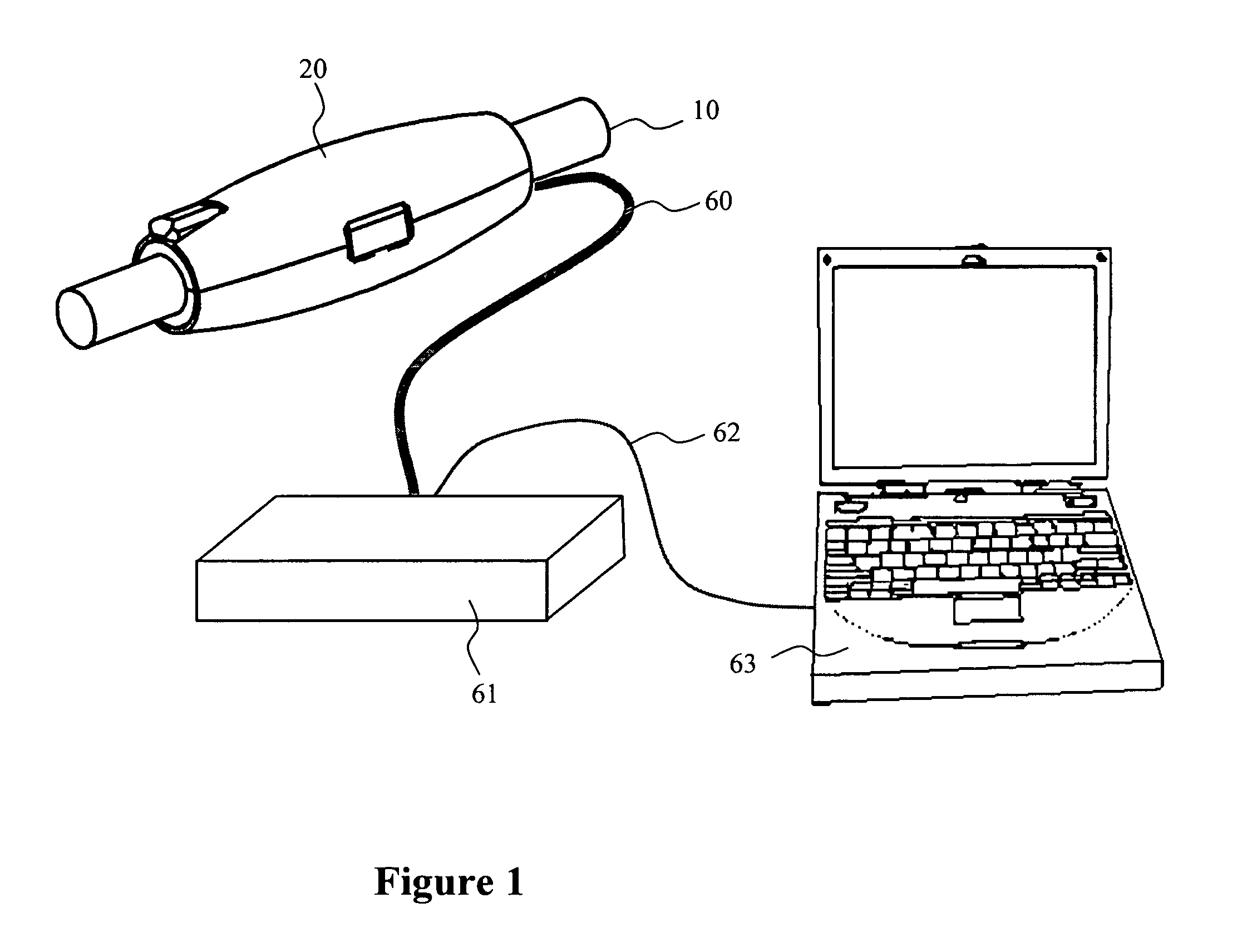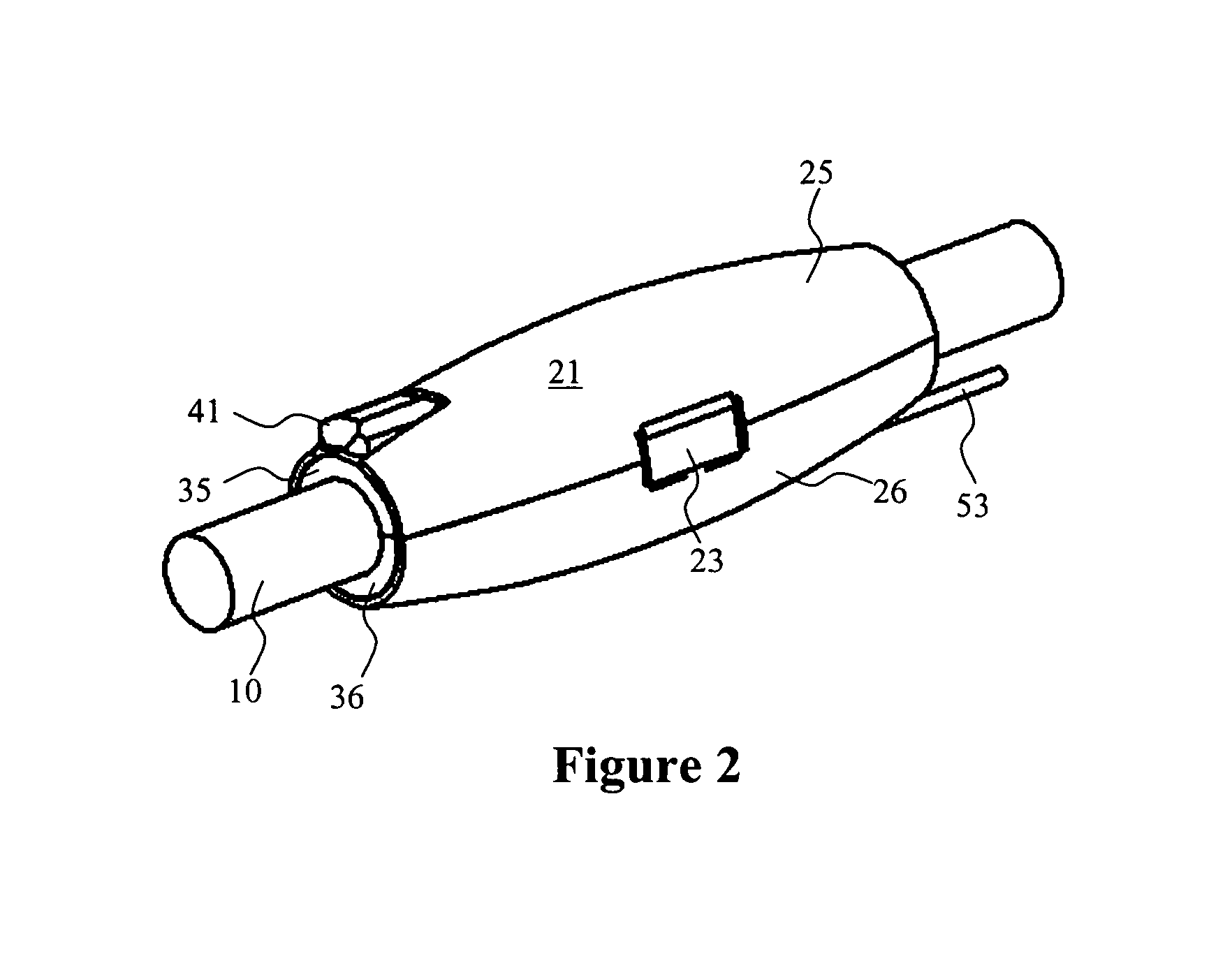Colonoscope handgrip with force and torque monitor
a technology of force and torque and monitor, which is applied in the field of colonoscopy handgrip with force and torque monitor, can solve the problems of excessive force, variation in force applied, and pain in force applied to the colon and its anatomic attachment, and achieve the effects of reducing the risk of infection
- Summary
- Abstract
- Description
- Claims
- Application Information
AI Technical Summary
Benefits of technology
Problems solved by technology
Method used
Image
Examples
first embodiment
[0043]The handgrip 20 will now be described in more detail. the handgrip is shown in greater detail on FIGS. 2–7. The handgrip 20 consists of an external sleeve 21 slidingly positioned over an internal sleeve 30 with an engaging means 50 located therebetween. The external sleeve 21 has a shape adapted for easy grip by a human hand as shown on FIGS. 2 and 6. In its preferred configuration, the shape of the external sleeve is such that it covers almost entirely the internal sleeve 30 so that the operator holds the entire device only by the external sleeve. To allow its placement over the shaft 10 of the colonoscope, the external sleeve 21 is made in two halves 25 and 26 connected together on one side by a spring 22 biased in a way as to allow them to open when the clamp 23 is released. The spring 22 is also positioned to allow one half of the external sleeve to swing away and towards another. Alternatively, the halves 25 and 26 may be molded from a polymer material with a living hinge...
third embodiment
[0055]The engaging means is arranged as a combination of radial 254 and longitudinal 255 sets of engaging plates. Each plate is equipped with a sensor to measure its deflection as a function of force applied to one side of this plate. Strain gage sensors can be used advantageously for this purpose along with other sensors known in the art. Application of longitudinal force such as for the purpose of advancing the colonoscope would cause the longitudinal set of plates 255 to bend, which will be detected and recorded by the sensors. Rotation of the shaft will correspondingly cause the radial set of plates 254 to bend as will be captured by their sensors. Therefore, the entire picture of force and torque application can be accurately monitored. As shown on the drawings, the two sets of plates could be extended to be positioned at the opposite ends of the handgrip but that is not absolutely necessary for the accurate function of the device.
[0056]Finally, the internal sleeve support sys...
fourth embodiment
[0058]the invention is shown schematically on FIGS. 16 and 17. It includes a further modification of the pair of release buttons 341 now positioned in the center of the grip right under the palm of the operator. The main feature of this release system is that centrally located release buttons 341 control two sets of levers located opposite each other, one in the front of the handgrip and the other in the back. Therefore, as many as 4 levers grip the shaft of the colonoscope both in the front and in the back, which further reduces the chance of slipping even when the shaft is wet. As in previous embodiments, the springs 345 support each release button in its engaged or “normally closed” position making the device disengaging the shaft only when the release buttons 341 are depressed.
DETAILED DESCRIPTION OF THE FIFTH PREFERRED EMBODIMENT OF THE INVENTION
[0059]This embodiment is similar to the previous embodiments with the main difference being the use of an elastic single-use protectiv...
PUM
 Login to View More
Login to View More Abstract
Description
Claims
Application Information
 Login to View More
Login to View More - R&D
- Intellectual Property
- Life Sciences
- Materials
- Tech Scout
- Unparalleled Data Quality
- Higher Quality Content
- 60% Fewer Hallucinations
Browse by: Latest US Patents, China's latest patents, Technical Efficacy Thesaurus, Application Domain, Technology Topic, Popular Technical Reports.
© 2025 PatSnap. All rights reserved.Legal|Privacy policy|Modern Slavery Act Transparency Statement|Sitemap|About US| Contact US: help@patsnap.com



